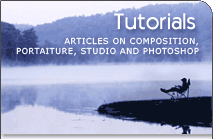This article belongs completely to Ed Shapiro, a professional photographer, who contributed a lot to the art. It is based on the content of a topic of forum. I have to thank Ed for covering this topic. I could not find any place where Ed gathered and published his knowledge, so I decided to extend the audience of the forum where he posted this topic. So here it goes...
Window Light Studio
Northern exposure will yield the best light. You might want to place some Rosco diffusion sheets or scrims over the other windows to modify the sunlight.
If you wish to use the window in the photograph - window treatments are in order. There is any number of sheer and translucent materials that will look good - the rest is a matter of taste - country, colonial, modern, criss-cross, tufted fabrics or classical designs. Problem is - your light source is in the picture and might become overexposed thereby creating a distraction and loosing detail. What I do is use a split neutral density filter in the vertical position. With the lens stopped down to the working aperture, I position the darker side of the filter over the window area and the clear side on the same side of the subject. At wide F/stops there is no visible demarcation and you will have even exposure and easy to print image. I use some custom made glass ones in different densities that are kind of pricey - the regular optical plastic ones will do nicely at a fraction of the price.
If you are using the windows strictly as a light source, you needn't decorate them but you might want to baffle them to get various lightings. Black paper or gobos can create a slit of light that is very dramatic. You can use a background behind the subject and control the amount of light hitting it with blinds or gobos. You can fill in with a reflector or use just a touch of light from a small electronic flash unit covered with diffusion material or several layers of white cloth. If the window light, measured with an incident light meter at the subject, aimed at the camera, gives you say - 1/60th of a second @ f/5.6 - attenuate the flash to f/2.8 for a dramatic but detailed lighting ratio. A very soft peripheral fuzzy vignette also works well in these situations providing the vignette does not call attention to itself.
A lot of potentially good window light portraits are marred my including undressed windows in the compositions and by having the light coming in the window dominate the tonal values of the print. Good luck – It's always fun designing a new camera room.
~ Top ~Window Light
There are many misconceptions about window light portraits. One major mistake is including the window itself in the composition, unless it is a decorative window, a bay window with a seat or a window with a picturesque view which you want to include in your photograph. The window, except in the aforementioned cases is you light source only and should not be seen. It should not show at all or placed in a part of the negative that can be easily cropped out.
Window light by its very nature is very directional and in most cases needs some form of fill lighting to render proper shadow detail and highlight balance. Flat reflectors are very good because you can see exactly what your ratio will look like. My method is to find the light, place the subject in the lighting pattern and check for a proper lighting form, such as modified butterfly or loop lighting. Then add the reflector fill and when the ratio looks good - just bring the reflector in and add a bit more fill light. This will give you the ratio you saw just before adding a bit of light. Flash fill can be used as well, but at a very low power to prevent overfilling the subject and destroying the mood that is indicative of window lighting. A flash unit that can be powered down, bounced or covered with several layers of diffusion material or a white handkerchief will do the job. The best window lighted images are shot at wide apertures thereby accommodating selective focus and the gentle use of a vignetter. On MF I do all my window lighted shots with my 150mm lens at f/4 to 5.6 - max f/6.3.
~ Top ~Other tips
If the window is included in the shot- a gray graduated neutral density filter can be oriented vertically to calm down the incoming or outside light that will now be showing in the image.
Window drapes can be used as barndoors to control the light and can be pulled aside and draped in a diagonal pleat to serve as an interesting background.
North light is the best but if it is not available the window can be covered with a scrim- I use a clean translucent shower curtain liner (under 10 bucks) that magically turns glaring sunshine into soft north window soft light.
When establishing subject and camera position, watch your background. A plain wall behind the subject can serve as a low or high key background, depending upon how much light is allowed to strike it. A painted background can be used or underexposed and out of focus elements of the home interior can make for interesting backgrounds as well. When photographing people like your subject in your prints - move the a bit further from the window and get the light to wrap around a bit more. Use somewhat darker clothing and avoid short sleeves. Don't cut of arms - have the subject fold them in a comfortable position, pose the arms in a more dynamic way or use supportive props to better define the arms and hands.
All the best! Hope this helps. ![End of the article [end of the text]](http://www.romanzolin.com/img/misc/text_end_ed.png)





